Everything Sourdough Bagels by Max Blachman-Gentile, Tartine Bakery

Max Blachman-Gentile is currently the Director of Culinary Operations at Tartine Bakery. Previously, at The Standard Hotel in New York, he started a bread programme using locally sourced, freshly milled grain. He grew up in Oakland, California, and was indoctrinated in the Bay Area culture of sourdough bread from an early age.
This recipe for Everything Sourdough Bagels has been very kindly given to us by Max, and it, along with many other recipes by bakers from all over the world, can be found in the book Knead Peace: Bake for Ukraine by Andrew Green. £2.50 from the sale of each book goes towards the Ukraine Humanitarian Appeal of the Disasters Emergency Committee.
Inspired by the resilient spirit of Anna Makievska and The Bakehouse, Kyiv, who have continued to bake day and night throughout the conflict, Knead Peace is a unique collection of beautiful bakes in support of Ukraine.
Donated by esteemed bakeries from across the globe, they include sweet and savoury breads, indulgent cakes and cookies, and delicious pies and tarts.
At the time of writing this well over a year has passed since the devastating conflict began, and we wanted to remind everyone about the book by featuring some of it’s sourdough recipes.
Increase diversity
The wholegrain flour used in this recipe can be replaced with our Botanical Blend flour
Everything Sourdough Bagels recipe
This recipe is naturally leavened, meaning it requires a sourdough starter. To keep your starter active enough to get the volume and fermentation you want, you will need to feed the starter at least twice a day, about 12 hours apart, and then prepare your leaven from the starter a few hours before mixing the bagel dough.
Serving size: makes 8 bagels



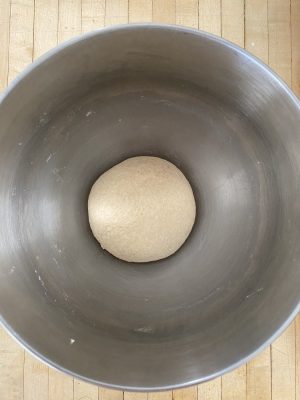



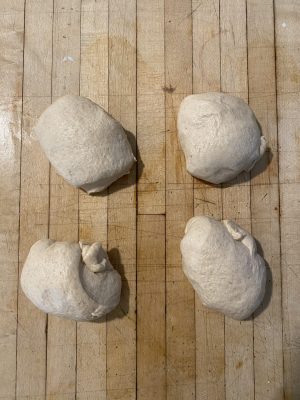
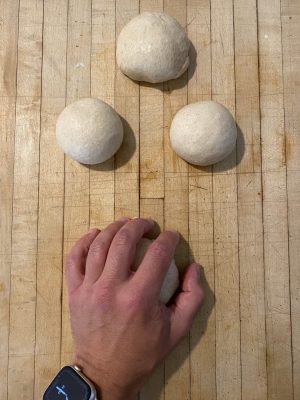
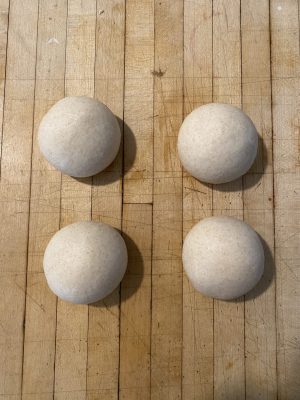





Ingredients:
Everything Spice
- 100g sesame seeds
- 100g poppy seeds
- 50g caraway seeds
- 50g mustard seeds
- 50g nigella seeds
- 25g sea salt flakes
Leaven
- 110g warm water, at 90–100°F (32–38°C)
- 150g ripe Sourdough Starter (see pages 12–13 of the book), just starting to collapse (should smell sweet with a little sourness, not vinegary yet)
- 75g strong white bread flour (12–13% protein content)
- 25g strong wholemeal flour
Final Dough
- 282g water
- 104g strong wholemeal flour
- 416g strong white bread flour (12–13% protein content)
- 173g Leaven (see above), just starting to collapse
- 39g malted barley syrup
- 13g salt
For boiling
- molasses (or malted barley syrup)
- bicarbonate of soda (baking soda)
Method:
1. To make the everything spice: in a mixing bowl, combine all ingredients and mix very well. This recipe will make extra; it keeps well indefinitely in a sealed container.
2. To make the leaven: mix all ingredients until all of the flour has been fully incorporated. It won’t develop gluten, but there should be no clumps or bits of dry flour. Cover with a tea towel and leave in a warm place for 3–4 hours. It should ferment quickly and will be ready to use when it has fully risen, there are plenty of bubbles at the top, it smells sweet and slightly sour, and it just barely starts to collapse in the middle.
3. Combine all of the final dough ingredients in the bowl of a stand mixer fitted with a dough hook, then mix on speed 2 until everything comes together into a cohesive dough. Or if mixing by hand, mix together in a bowl until everything is fully incorporated. Cover and let rest for about 15 minutes. This isn’t a full autolyse; it just gives the flour some time to hydrate and will make mixing a bit easier.
4. After resting, mix until a smooth dough comes together. If mixing in a stand mixer, keep on speed 2 or 3, and mix for about 5–6 minutes. If mixing by hand, you may want to also knead directly on a clean surface for about 6–8 minutes.
5. When the dough is ready, it will have a nice spring to it when you poke it, it shouldn’t feel sticky, and it should have a bit of a shine on the surface. Move the dough to a lightly oiled container and let it bulk ferment, covered, until the dough increases in volume by about 30–40%. The dough should start to get gassy and should feel stronger and more extensible. This will take roughly 3–4 hours but can change depending on a lot of variables like temperature, how active your leaven is, how fresh your flour is, etc.
6. The easiest way to determine how much volume your dough has gained during bulk fermentation is to use a clear container with straight walls so that you can mark the wall with a piece of tape to mark the height of the dough when you first put it in the container. Then you can use a ruler (or just eyeball it) to mark how much higher the dough needs to be to increase 30–40%.
7. When the dough has risen to the higher piece of tape, you are ready to divide. Once the dough has enough volume and is ready to divide, carefully tip it out of the container on to a clean surface. Using a bench scraper and a scale, divide the dough into 125g portions.
8. Once the dough has been divided, round each portion into a pretty tight boule. To do this, cup your hand around each portion of dough with your fingertips pressed to the surface of the counter and your palm touching the piece of dough. Rotate your hand in clockwise circles around the dough so that the bottom of the dough sticks to the surface, but the circular motion pinches the edges of the dough back underneath the ball of dough itself. You are trying to get a tight little ball of dough that doesn’t immediately lose its shape.
9. Line a baking tray (sheet) with a piece of baking paper that has been lightly sprayed with nonstick spray. When all of the portions of dough have been pre-shaped into boules, place them on the tray. Don’t put them so close to each other that they will stick together. Lightly spray them, cover them with clingfilm (plastic wrap) and place in the refrigerator overnight, ideally for 12–16 hours.
10. The following day, remove the dough balls from the refrigerator so they come back to room temperature. While waiting for the dough to temper, preheat your oven to 250°C (500°F), Gas Mark 10, and set the rack toward the top of your oven so that they colour evenly and don’t burn on the bottoms while you bake them. If you have a pizza stone, put this in the oven during the preheating.
11. Bring a large, wide pot of water to a boil. You want the pot of water to be wide and shallow rather than narrow and deep so that you can fit in as many bagels as possible.
12. When the dough is room temperature, your water is boiling, and the oven is preheated, add about 2 tablespoons of molasses or malted barley syrup to the boiling water, and 1 teaspoon of bicarbonate of soda (baking soda).
13. Get your everything spice ready on a plate or a tray. You will also need a couple of baking trays (sheets) lined with nonstick baking paper and lightly sprayed with nonstick spray.
14. To shape the bagels, use a finger to poke a hole right in the centre of the dough ball. Pick up the dough so that it fits around your finger like a ring, and gently stretch and rotate the dough around your finger over and over again until you have a bagel-sized ring with a hole in the middle of about 2.5–4cm (1–1½ inches) in diameter.
15. When the bagels have been shaped, gently and carefully place them into the boiling pot of water. Fit as many as you can at once so that an even layer floats on the top, close to each other but not touching. Boil for 1 minute, then carefully flip on to the other side. Boil for another minute, then remove the bagels oneby- one from the water using a slotted spoon or skimmer and place the top (smooth) side directly into the everything spice.
16. The bagels will have gotten about 50% bigger during the boiling process. Gently shake the bagel around in the everything spice so that it gets coated very well. Move each bagel to the lined trays, and repeat until they have all been boiled and rolled in everything spice.
17. Once the bagels are all boiled and coated with the spice mixture, make sure they are evenly spaced on the trays, spice-side up, so that they don’t touch while baking. Keep in mind they will still rise a bit more in the oven. Bake all of the bagels in the oven for 8 minutes.
18. Rotate the trays so that the bagels bake evenly, and bake for another 4–6 minutes depending on how dark you like your bagels to be.
19. Pull the bagels from the oven, and move them to a cooling rack so that they can cool completely.

You can follow Max here:
- Max is Director of Culinary Operations at Tartine Bakery
- Instagram @maxbeegee
- Website: maxbeegee.com
If you don’t already have a copy you can buy Knead Peace: Baking for Ukraine here.
Further recipes from Knead Peace on The Sourdough Club:
Seeds of Solidarity Porridge by Vanessa Kimbell
Deluxe Danish Seeded Rye by Richard Hart
Watch our BALM Podcast:
Club Members can listen to Vanessa Kimbell and Max Blachman-Gentile In Conversation here.

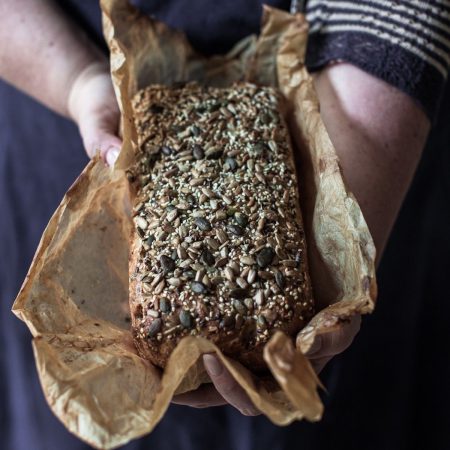


Leave a Reply